Catacombs in Paris - sightseeing, tickets, curiosities and a movie for the inquisitive
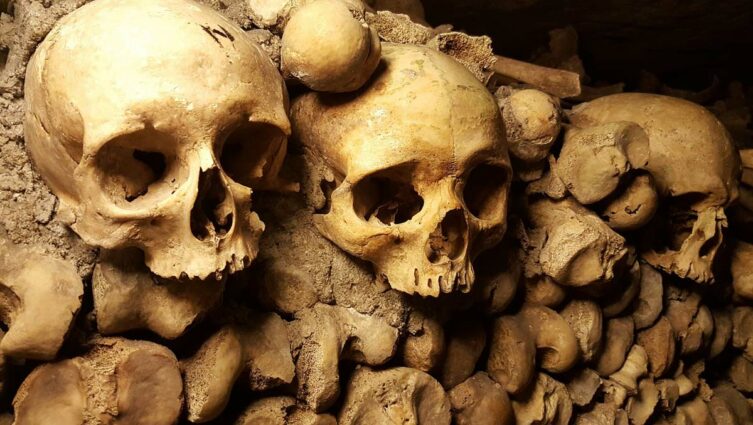
Stop! It's the empire of death!
Such an inscription at the entrance welcomes visitors to the catacombs in Paris. For some, it is a warning that additionally chills the blood before they descend the stairs to (probably) the largest necropolis in the world. For others, an incentive that makes them eager to get in. Depends on who and what they like. While you are here, notice that both of them in the queue to enter show a certain kind of nervousness and excitement.
Either way, the catacombs in Paris are surprisingly popular, and queues for tickets in high season are often more than two hours long. Even in the off-season, there are rarely days when there isn't a solid queue here. Amazing!
It amazes me all the more that you can buy an admission ticket buy onlineon the website of the official distributor at the same price as in the checkout window. It is true that theoretically there is such a thing as a “last minute” admission ticket, which is sold at the last minute for a specific hour (about 50% cheaper), but what are the chances of getting it? Rather zero! Because the "last minute" tickets are mainly those that have not been sold online before. I wouldn't really count on it.
Looking at the booking calendar available on-line (I'm writing these words, off-season, in December) I see that all tickets are sold 1,5 - 2 weeks ahead, and weekends are sold out completely a month ahead. It must be a real massacre here during the tourist season.
Let's leave the ticket issue for now. Who wants to come in, just take care of it in advance and that's it. For the sake of simplicity, I provide link to the sale of tickets to the Catacombs in Paris via the Internet – [click].
The largest necropolis in the world
About 12 million people live in Paris. After Istanbul and Moscow, it is the largest city in the old continent. After many hours of exploring it on your own feet, you will be able to see how powerful the city of 12 million people is. This will be very important in the context of imagining the size of the Paris catacombs.
By the way, I would like to add that Wadi-al-Salaam, located in Iran, is generally considered to be the largest cemetery in the world. According to official figures, more than 5 million dead are buried in the Iranian cemetery. A small fragment of the Iranian cemetery is shown in the photo below.
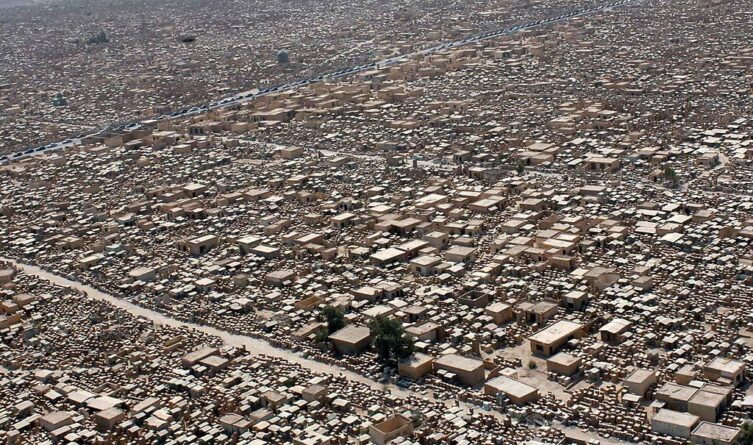
I also posted a photograph of the world's largest cemetery not by accident. Imagine that in the catacombs of Paris there are remains of over 6 million (!!!) people. Yes! This is not an error! Paris catacombs in this regard are bigger than the largest cemetery in the world, and at the same time it is practically half of the city's current population.
You could say that there is a second city outside Paris: the city of the dead. And there will be no exaggeration in this, especially in the face of the facts that I will tell below.
How were the catacombs created?
It started very innocently in medieval times. The rapidly expanding Paris needed a huge amount of building materials. Fortunately, in the vicinity of the city, on the left bank of the Seine, there were natural deposits of Eocene limestone, perfect for building materials.
The exploitation of the deposits started and lasted for about 500 years. At that time, Paris was getting bigger and bigger, and the mines had to dig deeper and deeper to satisfy the appetite of the fast-growing city. The network of shafts and corridors grew, gaining new branches and levels until ... the city grew so much that it also covered the mine area. The operation had to be terminated.
Areas that used to lie outside the city became part of it and the city began to grow over the abandoned, empty mine workings (now districts 5 and 6 and partly 13 and 14).
The second (i.e. right) bank of the Seine, due to the muddy ground, initially enjoyed less interest. Obviously, it's harder to build on mud. Initially, this area seemed to be a good place for a safe location of the main city cemetery. Located close to the city, in a safe and theoretically unattractive area, the area had all the features of an ideal place. In this way, the main and largest cemetery at that time was created: Cimetiere des innocents.
The availability of appropriate building materials, better and better construction technologies and builders' skills, as well as the wealth of the residents of dynamically developing Paris, made what seemed impossible until recently, now within reach. The softness of the ground ceased to be a problem and the city quickly began to develop also on the right bank. The cemetery, isolated until recently, was quickly absorbed by the city and already in the XNUMXth century the cemetery was located in the very center, adjacent to the main commercial market (now Les Halles).
It only got worse from there. Even the construction of a three-meter-high wall surrounding the cemetery, which was supposed to effectively isolate the necropolis from the neighboring market, did not help. The graveyard was bursting at the seams with the new corpses that were constantly being supplied by the city, which was growing at a frantic pace. Due to the lack of space, it became impossible to bury people in individual graves. Only collective graves were created, containing about 1500 people. A new grave was dug only when the previous one was full.
In the following years (especially in the XNUMXth and XNUMXth centuries, during the plague epidemic), the inhabitants of the district even undertook their own initiatives, adding arched structures to the wall of the cemetery, which (due to the functions they performed) were colloquially called morgues. In order to regain space in the cemetery for new burials, old tombs were dug up and the bones taken out of them were stored in the added buildings, creating a bone repository there (hence their name).
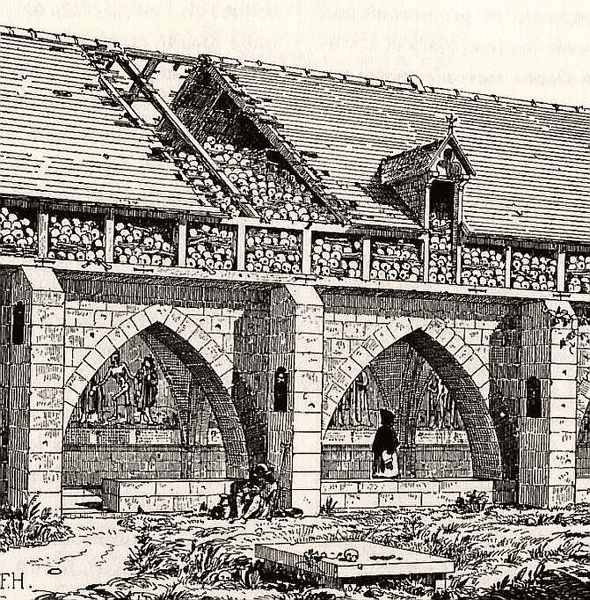
source: wikipedia, public domain
Louis XVI tried to save the case by wanting to ban new burials and order the cemetery to be moved outside the city. However, he relented under the pressure of the church, which supported itself from fees for burials. In return, the church radically increased fees, hoping that this would limit the number of funerals at the Cimetière des Innocents, and at the same time would not reduce the proceeds.
Katastrofa
A catastrophe had to happen for something to change. The spring of 1780 arrived, and with it heavy rains. Just then, during one of the rainy days, the walls of one of the buildings adjacent to the cemetery failed and collapsed under the pressure of dead bodies. Everything spiraled out of control and miraculously did not end with a huge epidemic. Radical decisions were needed.
At the beginning, a ban on new burials was introduced in all cemeteries within the city limits. Then it was time for another decision: the largest cemetery in Paris, Cimetière des Innocents, was to be liquidated, and with it all the other small cemeteries functioning within the city limits. The remains are to be exhumed and moved to empty excavations, after abandoned Eocene limestone mines.
All closed cemeteries are to be replaced by three large ones: Montparnasse, Père-Lachaise and Passy.
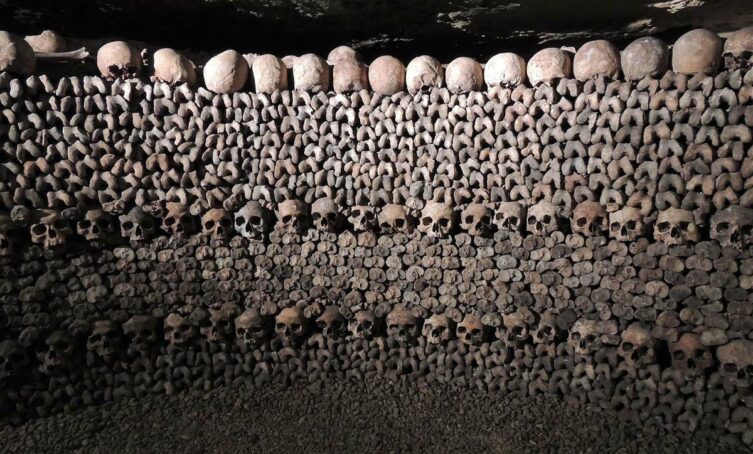
Death convoys
The consequences of all the events and decisions described above were visible on the streets of Paris for many years to come. In the evenings, after dark, carts covered with black cloth moved through the streets of Paris between cemeteries and mine workings. Consistently, day after day, they transported the remains extracted from the liquidated cemeteries and delivered them to the place of storage, to the mine excavations. Initially, the transports had the character of a procession, accompanied by appropriate church celebrations. After a few years, the journeys lost their sacral character and eventually turned into routine transports.
The whole operation began in 1795 and lasted until 1814. During this time, the remains of about 6 million people were transported, 2 million of them from the Cimetière des Innocents cemetery alone.
Later, burying the dead directly in the catacombs became the norm.
In this way, the old mine excavations turned into the world's largest catacombs and, paradoxically, apart from death, brought to them a parallel, still active and not entirely legal life (more on that in a moment).
The total length of the corridors forming the catacombs near Paris is almost 300 km (!!!), of which about 1,5 km are open to the public.
Hell's Gate - visiting the catacombs
By a strange coincidence, the entrance to the Paris catacombs is located in one of the two twin buildings that once formed the entrance gate to the city and are called: Hell's Gate. What's even weirder is that the name really has nothing to do with the catacombs! It was created in completely different circumstances. Historians point to several sources for it, but none are related to the catacombs.
You can get to the catacombs easily, because there is a metro stop very close to them Denfert-Rochereauwhere lines 4 and 6 stop. It is far enough from the very center of Paris that I advise you to save your legs and time, and I recommend arriving by metro.
You can find the site plan and the location of the catacombs on the map of Paris below.
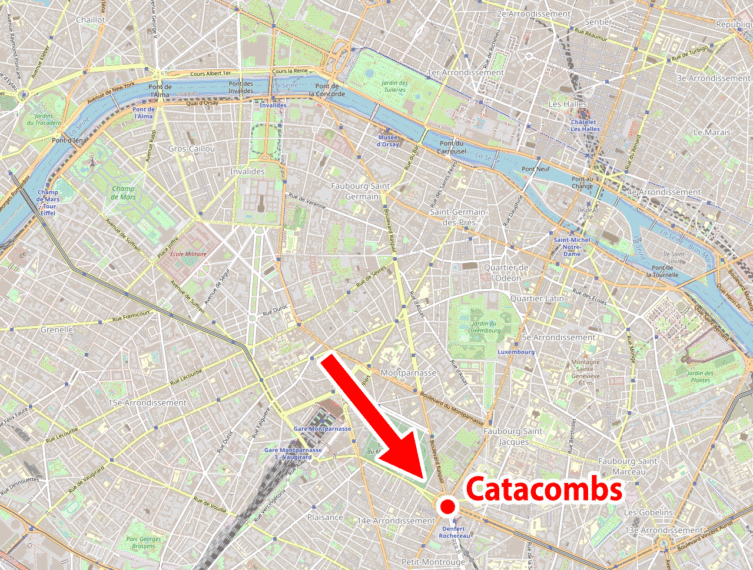
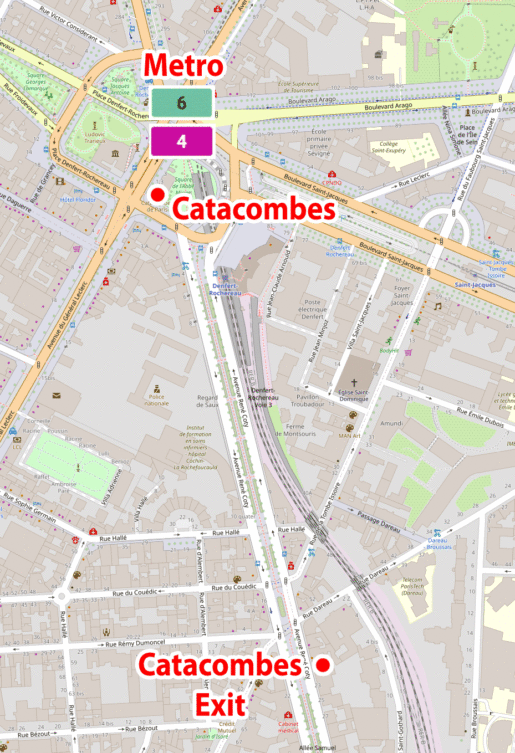
The underground tour of the catacombs is about 1,5 km long and does not form a loop. This means that you enter the catacombs in one place and come out in another (the exit is at: 21 Av. René Coty, 75014 Paris).
The air in the catacombs has high humidity and a temperature of about 14 degrees.
Visiting the catacombs takes approximately 45 minutes. The route is not adapted to people with mobility limitations. There are 131 stairs to climb down and 112 at the uphill exit.
Before visiting, it is worth downloading and reading a short, official one sightseeing plan – [click], prepared by the museum Les Catacombes de Paris. I just downloaded the guide provided here from the official website of the catacombs.
Opening hours Catacombs in Paris:
– from Tuesday to Sunday: 9:45 – 20:30 (last visitors are admitted at 19:30)
- Closed on Mondays and public holidays
Entrance to the catacombs in Paris, GPS coordinates:
48°50’01.9″N 2°19’56.5″E
48.833853, 2.332350 – click and route
Exit from the catacombs in Paris, GPS coordinates:
48°49’46.2″N 2°20’03.9″E
48.829508, 2.334423 – click and route
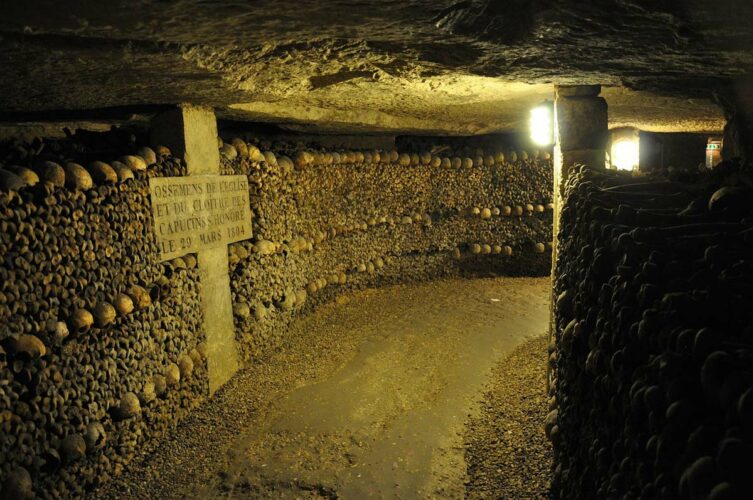
Alternative Life of the Catacombs
For a long time, the catacombs led a peaceful life. Specially appointed institutions supervised their functioning. From time to time, cleaning works were carried out in selected places, protecting against collapse or even regulating the behavior of high groundwater that appeared from time to time. Even special aerating shafts were created. Some of the bones were stacked, separate rooms were created, in which commemorative plaques appeared.
cataphiles
In the 60s, something changed. There began to be an increased interest in the catacombs from small groups of students associated with the Paris National School of Mining and the Faculty of Pharmacy of the University of Paris. Both universities are located in an area with a dense network of former mine tunnels, and both of their basements had a direct connection to the labyrinth of mining galleries. It made it possible direct descent to the Paris catacombs directly from the university buildings.
Some started looking for information about the underground labyrinth in university libraries, and others started underground mining and creating their own maps of mine labyrinths. Hand-drawn maps quickly became the best and main source of information on the location of underground galleries. Due to the impossibility of copying them (then there were no devices allowing for quick copying, and the Internet did not exist), maps were available only to a small, selected group of enthusiasts, who were completely absorbed in exploring and exploring the catacombs. They quickly gained a name catafil, or catacomb lovers.
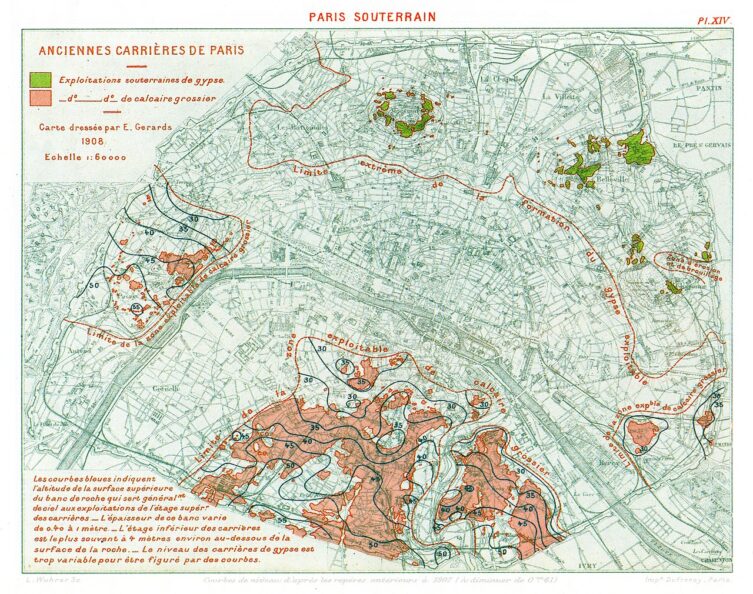
source: wikipedia, public domain
The news of an underground city near Paris spread quickly and attracted more and more curious people. Not everyone was interested only in discovering and describing them.
There were groups that took advantage of the secrecy of the underground and carried out illegal activities there. There were also lovers of various kinds of rituals, for which the catacombs formed a perfect background. In the largest known underground room, called "Z room” there was even an (illegal) concert of a classical orchestra, which was attended by over 100 people. Then other concerts took place: from jazz to rock (photos from Room Z can be found later in the text).
Some visitors to the underground expected to find valuables there (probably among the remains of the dead), and some carried out planned robbery activities. The underground was connected not only with the cellars of the universities I mentioned, but also with other buildings located in their area. For a long time, fragments of excavations were used, for example, by Parisian breweries and distilleries for storage and aging of finished products. Robbery search parties did not hold the catacombs in high esteem. So they devastated what did not arouse their interest and did not represent material value for them.
Curiosity:
Quite recently, in 2017, 300 bottles of old wine, with a total value of EUR 250, were stolen from one of the private cellars. The thieves broke into the cellar directly from the catacombs and took the wine this way.
But let's go back to the 60s.
The wild exploration of the catacombs continued for several years, despite the introduction of a total ban on entering them by the city in 1955. It was not until 1981 that the city decided to establish it special police department (The so-called. ERIC group) responsible for protecting, capturing and punishing illegal visitors to the catacombs. The commander of the police department was Jean-Claude Saratte, known as the "first cataphilia", as a young man participating in the first, spontaneous discoveries of the underground and for years associated with the Catafil exploration of the catacombs. Until his retirement in 2000, he cooperated and maintained constant contact with groups of cataphiles focused on the care and protection of catacombs against destruction by the so-called. "tourists" and ordinary vandals.
Taking turns almost constantly in the catacombs, the cataphiles provided the police with information about unwanted visitors to the underworld, and the police did the rest. Saratte kept the identities of the cataphiles working with the police secret.
A big change came when Jean-Claude Saratte retired from the police force. Relations between the cataphilia and the police have definitely deteriorated. The police more and more willingly began to use radical methods of limiting access to the catacombs, consisting in blocking passages by filling fragments of underground corridors with concrete. The method, commonly known as concrete injections, according to the cataphiles, violated the basic principles of caring for the heritage of the catacombs, irretrievably destroying the historical fragments of the tunnels.
The conflict between the catafils and the police escalated over time. It even got to the point that it was the kataphiles who followed the police, and not the other way around. On the occasion of the activities carried out, the kataphiles revealed that some of the police activities were fake. Places where theoretically concrete plugs should be made (a lot of money was paid for this) remained empty.
The cataphiles openly accused the police that the department appointed to protect the catacombs does not carry out any protective activities and never appears in the catacombs, but deals with "lucrative activities related to the environment."
The next few years brought another exacerbation of relations. Thanks to the police, about 300 entrances to the catacombs were welded, built up and concreted, leaving only a few. Inside the walkways, many new concrete partitions were created, which not only made it impossible to move around the catacombs, but also blocked the flow of air.
Currently, kataphiles regularly unlock selected entrances, e.g. cutting welds and cement joints with grinders. In many places, instead of unlocking difficult-to-forward blockades, they copy the so-called. "cat's flaps" (especially around concrete plugs) narrow, claustrophobic tunnels, bypassing the obstacle. Many of these cat flaps, acting as alternative entrances, were created in the tunnels of the Paris metro, which are adjacent to the quarries. Some illegal entrances also lead through sewer manholes.
You can see some photos from the catacombs on the slides below (scroll left and right). In the first photo there is Room Z, the one where the first concerts took place. I would like to point out that it is so nice and bright in the catacombs only in the pictures. Normally there is deep darkness here:
.
Illegal entry into the catacombs in Paris
Currently, access to the catacombs, apart from a short section open to the public, is strictly forbidden and prosecuted by the police, and the conflict between the catafils and the police is still ongoing.
What the police block, the kataphiles unlock. Where it is impossible to pass, new tunnels are dug.
The Catafil community counts from several dozen to several hundred people and strongly guards the secrets of the catacombs. He is reluctant to one-time guests (so-called tourists). Tourists are not welcome in the catacombs.
Just entering the catacombs, apart from being illegal, is currently extremely difficult and dangerous. A limited number of entrances and their nature (sewage manholes, active subway corridors, etc.), and at the same time a constantly changing layout of corridors, hand-dug claustrophobic burrows (cat's slippers), air circulation disturbed by concrete plugs, rising groundwater level causing flooding ... all this makes … more and more people willing to see the catacombs with their own eyes 🙂
The catacombs do not have their own maps, and those available on the Internet are only misleading and do not correspond to the real layout of the corridors. I've looked at a lot of material available on the web on this subject and basically everyone says the same thing: entering the catacombs without a catafil guide would end tragically. In these undergrounds, you lose your orientation very quickly. On the Internet, you can find a lot of information about people who never left the catacombs, or were fortunately found only after many days, in a state of extreme exhaustion.
Cataphiles spend a lot of time in the catacombs and often fill a large part of their lives. Sometimes they live here for many days without coming to the surface. They sleep, cook, eat, drink, sometimes even carry out minor construction and security work. They regularly clean the catacombs, collecting the remains of uninvited guests and explorers deprived of culture and respect for the visited place.
Music is sometimes heard in the catacombs and catafil parties are held. In 2004, the Parisian police even discovered a fully equipped cinema underground with a screen, projector, library of horror and dark movies. The cinema was equipped with a bar, tables and chairs. When a police squad came to take down the installation a day later, they found nothing but a note left in the middle of the room with the inscription: do not look.
In 2014, with the consent of the French government, the only feature film “As Above, So Below” was made in the catacombs. Of course it's a horror movie. No set design changes were made during filming. Only the piano and the car were dragged inside, which were then set on fire. The film received negative reviews and received little recognition.
For all those who are curious about the underground life, below is a video of the illegal exploration of the catacombs, recorded by one of the Polish explorers. I think that it will satisfy the curiosity of those interested in the subject, will stop them from entering the catacombs illegally, and the remains of the dead resting in the catacombs will have peace of mind.
Warning!
The movie has some strong moments (features a throne of human bones, walking through "cat's slippers" and getting through corridors with human remains). I do not recommend viewing by sensitive people and children.
Paris sightseeing itinerary
This post is part of a very detailed itinerary for Paris that I have developed. The plan is available for free and you can see it on the website: Paris sightseeing plan - map, tickets, attractions, monuments, accommodation, interesting factsAccommodation (legal) near the catacombs
Below are some suggestions of completely legal 🙂 accommodation near the catacombs. As a curiosity, I will only add that in 2015, an online intermediary in the rental of private accommodation (i.e. Airbnb) paid Paris 350 euros as part of its advertising campaign, in exchange for the possibility of organizing one legal overnight stay in the catacombs. There was no shortage of volunteers, and the offer of bed and breakfast was finally used by the mother and son (as far as I remember, the accommodation could not be bought, it was to be won in a competition promoting the company).
Treat the hotels I have selected below as a hint and a starting point for further exploration. Clicking on any of them will take you to the page with that hotel and, more importantly, it will generate a list of similar proposals. This will definitely make your search easier and will probably allow you to quickly find a satisfactory accommodation.
Hotel Le Clos d'Alésia – [click]
Tipi - [click]
Graphic Montparnasse – [click]
Important to me!
Give the article a good rating (5 stars welcome 😀)!It's free, a for me it is very important! The blog lives on visits and thus has a chance to develop. Please do it and ... thank you in advance!
If you like my guides, you will certainly find the one I created useful guide catalog - [click]. There you will find ready-made ideas for your next trips, descriptions of other tourist destinations and an alphabetical list of guides divided into countries, cities, islands and geographical regions.
I also post link to Facebook profile - [click]. Come in and press "Follow"then you will not miss new, inspiring posts.
Unless you prefer Instagram. I'm not a social media demon, but you can always count on something nice to look at on my instagram profile - [click]. The profile will gladly accept any follower who likes it.
I make the content I create available free of charge with copyright, and the blog survives from advertising and affiliate cooperation. So, automatic ads will be displayed in the content of the articles, and some links are affiliate links. This has no effect on the final price of the service or product, but I may earn a commission for displaying ads or following certain links. I only recommend services and products that I find good and helpful. Since the beginning of the blog's existence, I have not published any sponsored article.
Some of the readers who found the information here very helpful, sometimes ask me how you can support the blog? I do not run fundraisers or support programs (type: patronite, zrzutka or "buy coffee"). The best way is to use links. It costs you nothing, and support for the blog is self-generating.
Pozdrawiam



